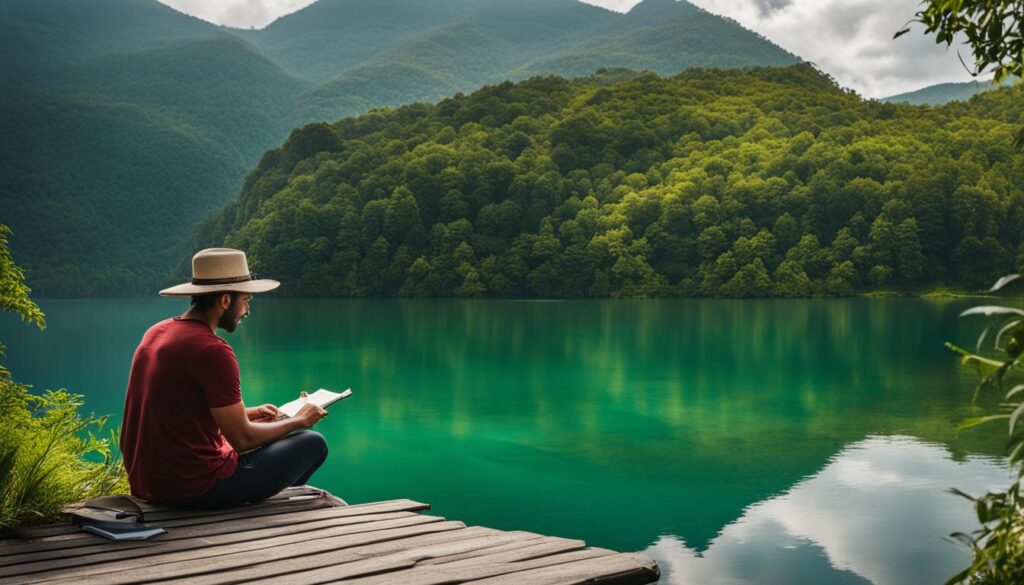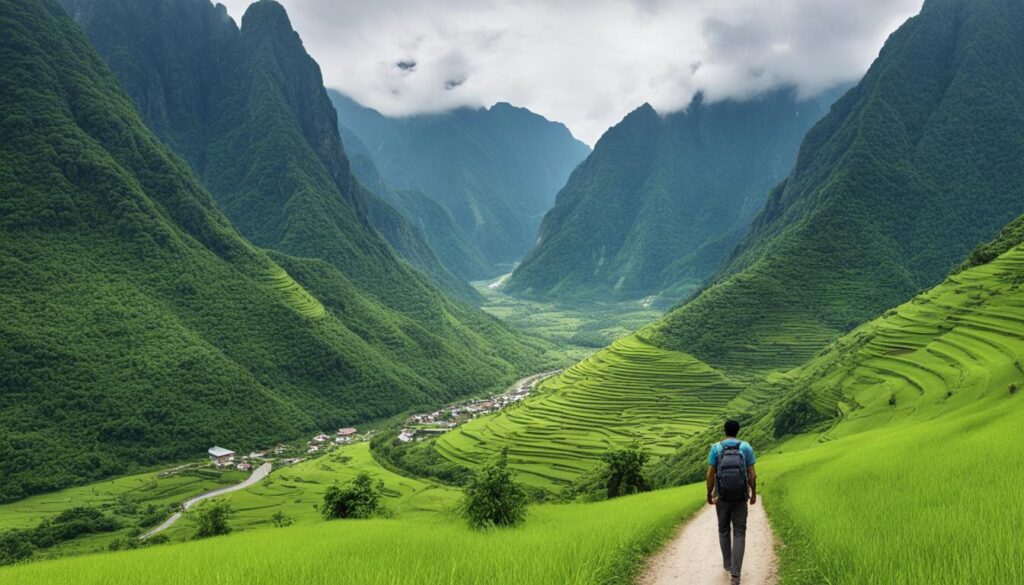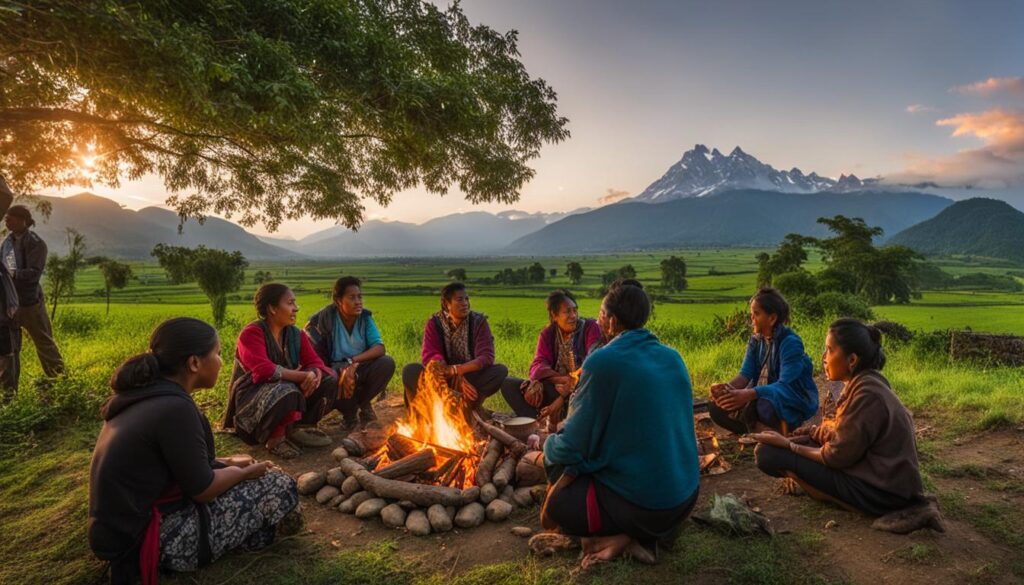Traveling can be a fantastic way to broaden your horizons, connect with different cultures and meet new people. However, in the rush to check off as many destinations as possible, we often forget to enjoy the journey itself. This is where the concept of slow travel comes in, encouraging a more relaxed and mindful approach to exploring the world. Slow travel involves taking the time to fully immerse yourself in your chosen destination, discovering its hidden gems and connecting with local communities. This section will explore the concept of slow travel and its numerous benefits, including sustainable tourism and mindful travel practices that allow you to savor every moment of your journey.
What is Slow Travel?
When you think of traveling, you might picture rushing from one famous landmark to another, ticking off a list of must-see sights. However, slow travel is all about embracing a different approach. It involves taking your time to enjoy the journey, savoring new experiences, and discovering hidden gems that are off the beaten path.
Slow travel prioritizes quality over quantity, allowing you to immerse yourself in a destination and truly get to know its culture, people, and way of life. This may mean spending a few days exploring a single location or staying in a small village rather than a bustling city.
One of the key elements of slow travel is the immersive experiences it offers. Whether that means taking a cooking class to learn how to make traditional dishes or joining a local festival, slow travel allows you to connect with a destination in a more meaningful way. These experiences can create lasting memories and a deeper appreciation for the places you visit.
Off the beaten path destinations are also a hallmark of slow travel. Instead of crowds of tourists, you might find yourself in small towns, countryside locations, or exploring nature reserves. These hidden gems allow for a more authentic experience, away from tourist traps and popular attractions.
Overall, slow travel is an approach that encourages you to take your time, connect with new places and cultures, and create lasting memories through immersive experiences and discovering off the beaten path destinations.
The Importance of Sustainable Tourism
Sustainable tourism is a key component of slow travel, helping to protect the environment and support local communities. By choosing eco-friendly accommodations and engaging in responsible travel practices, you can enjoy a more ethical and fulfilling travel experience. Moreover, eco-friendly vacations minimize the impact of tourism on the environment, preserving natural habitats and ensuring their longevity for generations to come.
Supporting local businesses and communities also plays a vital role in sustainable tourism, as it helps to ensure their economic stability and empowers them to maintain their cultural traditions and practices. By embracing sustainable tourism practices, you can enjoy your travels while minimizing the potential negative impact that tourism can have on the local environment and communities.
“Traveling – it leaves you speechless, then turns you into a storyteller.” – Ibn Battuta
Mindful Travel: Connecting with Cultures
Mindful travel involves interacting with local cultures in respectful and responsible ways. It’s about immersing yourself in a destination to gain a deeper understanding of its people and way of life. Here are some ways to foster cultural immersion experiences:
- Take the time to learn about local customs and etiquette before you travel, so you can show respect and avoid cultural misunderstandings.
- Stay in locally-owned accommodations, like small guesthouses or family-run hotels. This supports the local economy and gives you a glimpse into local life.
- Eat local food and shop at local markets to support small businesses and sample authentic cuisine.
- Engage in meaningful conversation with locals to gain insights into their lives and perspectives.
- Participate in cultural activities and events, such as festivals or traditional ceremonies, to learn more about local traditions and customs.
Cultural immersion experiences not only enrich your travels but also promote responsible tourism practices that support local communities.
“The world is a book and those who do not travel read only one page.” – Augustine of Hippo
Cultural Immersion vs. Cultural Appropriation
It’s essential to understand the difference between cultural immersion and cultural appropriation. Cultural appropriation refers to adopting elements of a culture without regard for their significance or meaning. It’s important to show respect for local cultures and not use them for personal benefit or gain. For example, wearing traditional clothing without understanding its cultural significance can be seen as disrespectful and inappropriate.
To fully embrace cultural immersion, it’s necessary to approach it with an open mind, respect for local customs, and a desire to learn and grow from the experience.
Embracing Slowness: Benefits for Travelers
Do you often find yourself rushing from one tourist attraction to the next, ticking off items on your travel itinerary without fully immersing yourself in the destination? Slow travel is a mindful approach to exploring the world, and it offers numerous benefits for travelers.
One of the main advantages of slowing down during travel is the opportunity to fully embrace your surroundings. Rather than rushing from one place to the next, slow travel allows you to take in the sights, sounds, and smells of your environment, enhancing your overall experience. You can fully appreciate the beauty of a local market, for example, by taking the time to browse the stalls and talk to the vendors.
By choosing slow travel, you’re also more likely to engage in experiential travel, which involves actively participating in local activities and immersing yourself in the culture. Whether it’s taking a cooking class with a local chef or hiking through a scenic wilderness, these experiences can be transformative and create lasting memories.
Another benefit of slow travel is the opportunity to meet new people and gain a deeper understanding of local communities. When you’re not rushing from one attraction to the next, you can spend more time talking to locals and learning about their way of life. This can lead to meaningful connections and a greater appreciation for different cultures.
Embracing slowness during travel can also have a positive impact on your well-being. By taking time to relax and recharge, you’ll return from your trip feeling more refreshed and rejuvenated. Slow travel allows you to escape the stresses of daily life and fully immerse yourself in the present moment.
“Slow travel has allowed me to connect with the people and places I visit in a much deeper way. I’ve discovered hidden gems that I would have otherwise missed, and I feel more connected to the world around me.” – Sarah, slow travel enthusiast
Overall, embracing the concept of slow travel can lead to more meaningful and transformative experiences. So next time you plan a trip, consider taking a step back and fully immersing yourself in your destination.
Choosing Off the Beaten Path Destinations
When it comes to slow travel, choosing off the beaten path destinations can significantly enhance your experience. Not only does it allow you to avoid over-tourism and crowds, but it also offers unique insights into local cultures and customs.
Exploring lesser-known destinations allows you to fully immerse yourself in the destination and its surroundings, enabling you to appreciate the journey at a more relaxed pace. You’ll have the opportunity to discover hidden gems that are often overlooked by tourists and connect with the environment on a deeper level.
While these destinations may require additional planning and research, the rewards are well worth it. Whether you’re seeking a peaceful beach retreat, charming countryside villages or culturally rich urban centers, there are plenty of off the beaten path destinations waiting to be discovered.
Benefits of Choosing Off the Beaten Path Destinations
| Benefits | Description |
|---|---|
| Authentic experiences | Uncover unique local traditions, customs and ways of life that are often overlooked in more popular destinations. |
| Less crowded | Avoid tourist hotspots and enjoy a more peaceful and relaxed travel experience. |
| Cost savings | Off the beaten path destinations are often more affordable, allowing you to stretch your budget and travel for longer periods. |
| Environmental sustainability | By avoiding overcrowded destinations, you’re contributing to the preservation of the local environment and ecosystems. |
| Genuine interactions | Connect with local communities on a deeper level and create meaningful and transformative travel experiences. |
When it comes to slow travel, choosing off the beaten path destinations is an excellent way to connect with the environment, support sustainable tourism initiatives and create memorable and authentic travel experiences.
Cultural Immersion: Getting to Know Local Communities
One of the most rewarding aspects of slow travel is the opportunity to immerse yourself in the local culture. Instead of rushing from one tourist attraction to another, slow travel enables you to truly connect with the community, learn about their traditions, and gain a deeper understanding of their way of life.
Whether it’s staying with a local family, attending a traditional festival, or participating in a cooking workshop, cultural immersion experiences allow you to see the destination from a new perspective and create lasting memories.
Connecting Through Language
Language is a powerful tool for cultural immersion. By making an effort to learn even just a few words of the local language, you can demonstrate respect and build relationships with the people you meet.
If you’re not confident in your language skills, consider taking a language class or hiring a local guide who can help you navigate cultural differences and provide valuable insights into the destination.
Supporting Local Communities
One of the key principles of slow travel is supporting local communities. By choosing to stay in locally-owned accommodation, dining at family-run restaurants, and purchasing souvenirs from local artisans, you can help to sustain the local economy and foster a sense of community.
| Eco-friendly retreat | Hotel chain |
|---|---|
| Owned by locals who incorporate sustainable practices into their business model, reducing their impact on the environment | Owned by a large, multinational corporation with little regard for environmental impact or community support |
| Provides guests with opportunities to connect with the local community and learn about their culture | Offers a standardized experience that is the same whether you’re in New York or Paris |
| Committed to responsible travel practices and supporting sustainable tourism initiatives | Focuses on profit over sustainability and community support |
Exploring Beyond Tourist Hotspots
Cultural immersion experiences often require you to venture off the beaten path and explore beyond the typical tourist hotspots. Seek out hidden gems, such as local markets, neighborhood festivals, or lesser-known museums, to truly get a sense of the destination’s culture and history.
Remember to remain respectful of local customs and traditions, and always ask for permission before taking photos or participating in cultural activities.
In the next section, we’ll explore the importance of responsible and conscious travel practices in slow travel.
Responsible and Conscious Travel Practices
When it comes to slow travel, responsible and conscious travel practices go hand in hand with sustainability and cultural immersion. By adopting these mindful approaches, you can ensure that your travels have a positive impact on the environment and local communities while fostering a deeper connection with the places you visit.
Reduce Environmental Impact
One of the most crucial aspects of responsible travel is reducing your environmental impact. This could include choosing eco-friendly forms of transportation, such as cycling or walking, or opting for public transport over rental cars. Additionally, staying in sustainable accommodations and minimizing waste by using reusable water bottles and shopping bags can help reduce your carbon footprint.
Support Local Businesses
Consciously supporting local businesses is a key aspect of responsible travel. This could involve eating at locally-owned restaurants, shopping at artisan markets, and choosing locally-run accommodations. By choosing to support local businesses, you are helping to contribute to the local economy and preserve local cultural traditions.
Respect Local Customs and Traditions
Respecting local customs and traditions is crucial in fostering positive relationships with local communities when traveling. Learn about the norms and cultural practices of the destination you’re visiting, and make an effort to abide by them, whether it be dressing modestly, removing your shoes when entering a temple or mosque, or avoiding taking photos of people without permission.
“Travel is more than the seeing of sights; it is a change that goes on, deep and permanent, in the ideas of living.” – Miriam Beard
Incorporating responsible and conscious travel practices into your slow travel experience can help to support sustainability, promote cultural immersion, and create meaningful connections with the places you visit. It allows you to travel with a sense of purpose and awareness, ensuring that your journey is both fulfilling and responsible.
Sustainable Accommodation Choices
When it comes to slow travel, choosing eco-friendly and sustainable accommodation options is a crucial aspect of supporting sustainable tourism. These choices help to reduce your environmental impact and support local communities through responsible travel practices. An excellent way to start your search is to look for eco-lodges or locally-owned guesthouses.
Eco-lodges and guesthouses offer unique and immersive experiences, providing a sense of place while also integrating sustainable practices into their operations. They often use renewable energy sources, have a minimal impact on the environment, and support local business initiatives. Local environmentally-conscious accommodations contribute to the improvement of the surrounding community and preserves the natural beauty of the environment.
By opting for sustainable accommodation choices, you are making a positive impact on the local environment and supporting the principles of eco-friendly vacations and slow travel. Not only does this help to preserve the environment for future generations, but it also provides an opportunity for visitors to learn about the area’s rich cultural heritage and traditions.
Uncovering Hidden Gems: Slow Travel Tips
Slow travel is all about taking the time to explore off the beaten path destinations, uncover hidden gems, and immerse yourself in local culture. Here are some practical tips and strategies for embracing slow travel:
1. Seek out local recommendations
When you arrive at your destination, don’t be afraid to ask locals for their recommendations on where to go and what to see. They may suggest hidden gems that are not in tourist guidebooks.
2. Plan your itinerary carefully
Rather than trying to visit every hotspot, plan your itinerary to allow for a more relaxed exploration of each destination. Prioritize the things that interest you the most, and leave room for serendipitous discoveries.
3. Embrace slow-paced activities
Instead of rushing from one tourist attraction to the next, embrace slow-paced activities such as walking tours, cycling, or leisurely picnics. This will allow you to fully immerse yourself in the surroundings and appreciate the journey.
4. Stay in locally-owned accommodations
Choose to stay in locally-owned accommodations such as guesthouses, bed and breakfasts, and boutique hotels. This not only supports the local economy but also provides authentic cultural immersion experiences.
5. Disconnect from technology
Slow travel encourages you to disconnect from technology and be present in the moment. Try to limit your use of phones and computers, and instead, focus on engaging with the environment and local communities.
| Destination | Hidden Gem |
|---|---|
| Thailand | The Chiang Rai province, home to stunning temples and hill tribe cultures. |
| Italy | The Aeolian Islands, a group of volcanic islands off the coast of Sicily. |
| Brazil | Paraty, a colonial-era town surrounded by lush rainforests and hidden beaches. |
Remember, slow travel is not just about the destination, but also about the journey. By embracing a relaxed and mindful approach, you can gain a deeper appreciation for the world around you and create unforgettable memories.
Exploring the Joys of Experiential Slow Travel
Experiential slow travel offers a unique and immersive way of exploring the world, allowing you to truly engage with your surroundings. Rather than rushing from one tourist attraction to the next, experiential travel involves participating in local activities, connecting with the environment and local communities, and gaining a deeper appreciation for the destination.
Slow travel is a key component of this approach, enabling you to fully embrace the journey and enjoy meaningful experiences that go beyond simply ticking items off a bucket list. By taking the time to connect with your surroundings, you can develop a deeper understanding and appreciation of the local culture, people, and environment.
Immersive experiences play a crucial role in experiential slow travel, whether it’s learning to cook authentic local cuisine, hiking through stunning natural landscapes, or volunteering with a local community project. These activities enable you to connect with your destination on a more profound level, creating unforgettable memories and fostering personal growth.
So why not embrace the joys of experiential slow travel on your next vacation? Whether you’re exploring a new destination or rediscovering a familiar one, taking the time to immerse yourself in your surroundings can lead to transformative experiences and a more meaningful way of exploring the world.
Conclusion
Congratulations on taking the first step towards embracing slow travel! By prioritizing immersive experiences, sustainable tourism, and cultural immersion, you are not only benefiting yourself but also contributing to the preservation of our planet and the well-being of local communities. Remember that slow travel doesn’t have to be a luxurious or expensive endeavor; it simply requires a willingness to slow down, be mindful, and explore off the beaten path destinations.
As you embark on your next adventure, keep in mind the importance of responsible and conscious travel practices, such as reducing your environmental impact and supporting local businesses. By choosing sustainable accommodation options and participating in local activities, you can truly connect with the destination and its people in a meaningful way.
Finally, don’t forget to enjoy the journey itself. Slow travel allows for a more relaxed and experiential exploration of the world, enabling you to uncover hidden gems and create lifelong memories. Whether it’s savoring local cuisine, learning a new skill, or simply taking in the scenery, remember to embrace the slowness and immerse yourself in the wonders of slow travel.

















































